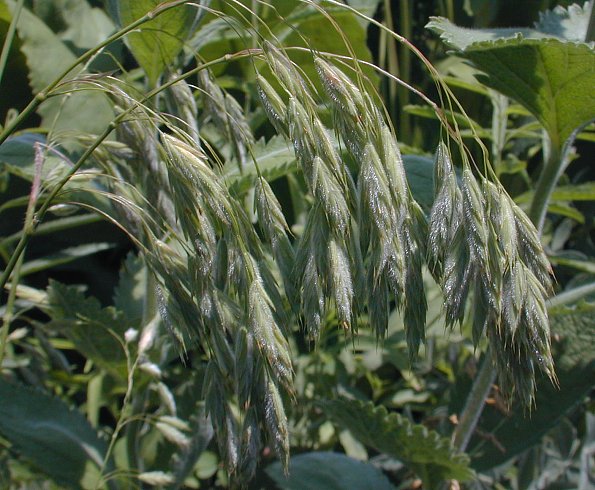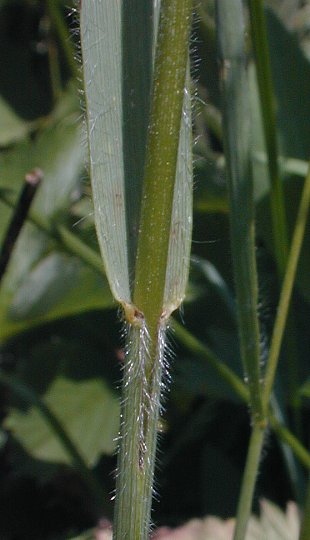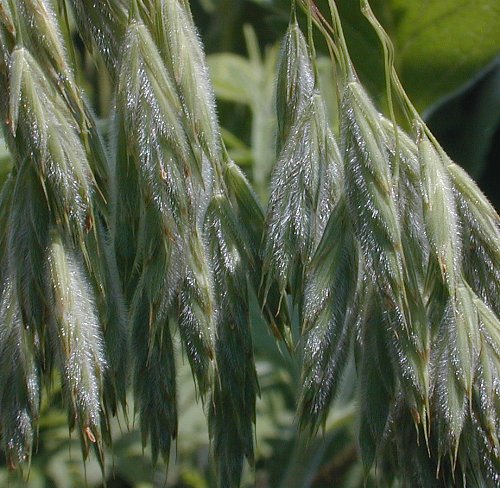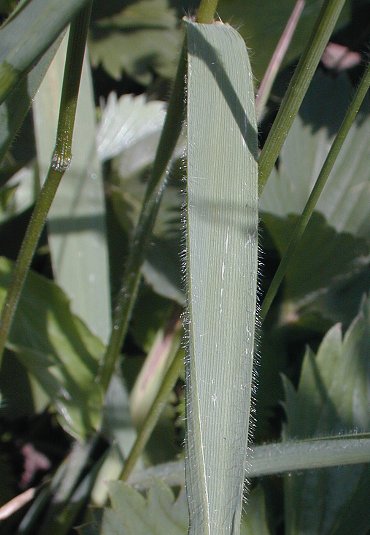Description: This grass is a short-lived perennial that becomes about 2' tall. It forms tufts of leaves from infertile shoots, while fertile shoots produce flowering culms with alternate leaves. Each culm is green, slender, terete, and unbranched; it is either glabrous, sparsely hairy, or slightly pubescent. The nodes of the culms are usually pubescent as well. Each culm has 3-5 alternate leaves along its length at flowering time. The leaf blades are up to 6" long and 8 mm. (1/3") across (or slightly larger); they are greyish blue, linear to broadly linear, and either flat or rolled upward along their margins. The leaf blade surfaces are mostly hairless, although long hairs are often present near their margins or along the central vein of their undersides. The blade margins are smooth (entire) in appearance, but rough to the touch from minute teeth. Leaf sheaths are mostly closed, although they become open toward their apices; they are greyish blue and usually quite hairy or pubescent.

Each culm terminates in an open panicle of spikelets up to 6" long. The weight of individual spikelets on their slender pedicels causes the entire panicle to lean over and droop. Each spikelet is up to 1" long, consisting of up to 10 lemmas above and a pair of glumes at the bottom that are arranged in 2 overlapping ranks. The glumes are about 6 mm. (¼") in length, linear-lanceolate in shape, and awnless; the short-awned lemmas are about 8 mm. (1/3") in length and elliptic-lanceolate. Both glumes and lemmas have longitudinal veins along their outer surfaces and they are both silky hairy or silky pubescent (with longer hairs along their margins than elsewhere). The slender rachis, lateral branches, and pedicels of the inflorescence are light green to light reddish green and glabrous to minutely pubescent. The blooming period occurs during early summer, lasting about 1-2 weeks. The perfect florets are cross-pollinated by the wind. Afterwards, the spikelets change color from silky light green to a dull light brown. The grains are narrowly ellipsoid. The root system consists of short rhizomes and fibrous roots.

Cultivation:
The preference is full to partial sun, moist to slightly dry
conditions, and soil with average to above-average pH containing
clay-loam, gravelly material, or calcareous sand. This plant is easy to
grow, but it tends to be short-lived. Most vegetative growth occurs
early in the year (from mid-spring to early summer); hot dry weather
can damage or kill this grass. Winter hardiness is excellent.
Range & Habitat:
The native Prairie Brome is an uncommon plant in central and northern
Illinois, while in southern Illinois it is largely absent (see Distribution
Map).
Illinois lies along the southern range limit of this species. Habitats
include open upland woodlands, mesic to dry-mesic prairie remnants, and
grassy fens. This conservative species is rarely found in degraded
habitats. In prairies, it becomes one of the understory grasses later
in the year.

Faunal
Associations:
Information about floral-faunal relationships is unavailable for
Prairie Brome, although it is probably similar to other Brome grasses (Bromus spp.).
Insects that feed on Brome grasses include the leaf beetle Chalepus walshii,
the seed-eating stink bug Aelia
americana (Eastman, 2003), Tetraneura ulmi (Elm
& Grass Root Aphid) and other aphids, larvae of Cephus cinctus
(Grass-stem Sawfly), larvae of the gall wasp Tetramesa bromicola,
larvae of the moths Elachista
illectella and Leucania
multilinea (Many-lined Wainscot), Camnula pellucida
(Clear-winged Grasshopper), and
Chortophaga viridifasciata (Northern Green-striped
Grasshopper). The relatively large seeds of Brome grasses are eaten by
various upland gamebirds, sparrows, and small rodents (ground
squirrels, mice), while the foliage is grazed by rabbits,
deer, elk, and livestock (cattle, horses, sheep).
Photographic Location:
The wildflower garden of the webmaster in Urbana, Illinois.

Comments: This is the only native Brome grass that can be found in Illinois prairies. The other native Brome grasses (Bromus spp.) occur in or near woodlands. Prairie Brome is an attractive grass that remains fairly short; it has greyish blue leaves and a nodding inflorescence that changes color as it matures. Prairie Brome can be distinguished from other Bromus spp. (Brome Grasses) by considering the following characteristics: 1) It is more hairy than most Brome Grasses, especially on the surface of its sheaths and spikelets, 2) each of its culms has only 3-5 alternate leaves, while other Brome grasses sometimes have more cauline leaves than this, 3) the glumes and lemmas have longitudinal veins along their sides (3-5 for each glume and 5-7 for each lemma), while the glumes and lemmas of other Brome grasses often have fewer such veins or they lack them altogether, and 4) the lemmas of Prairie Brome have short awns (up to 3 mm. in length), while other Brome Grasses often have lemmas with longer awns (exceeding 3 mm. in length) or they lack awns altogether. Other common names of Bromus kalmii are Kalm's Brome, Wild Chess, and Arctic Brome.